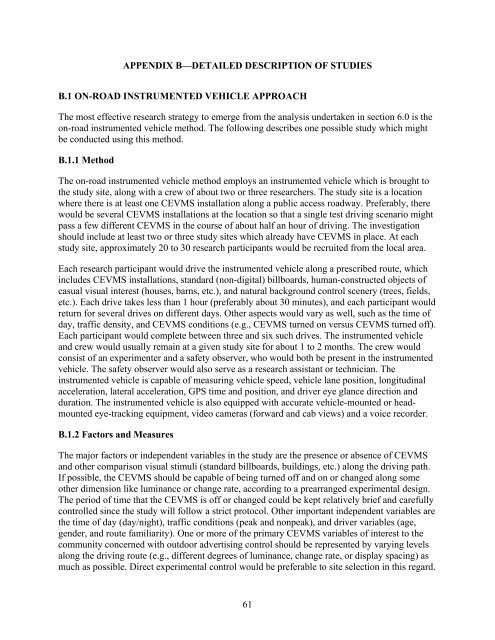The Effects of Commercial Electronic Variable Message Signs ...
The Effects of Commercial Electronic Variable Message Signs ...
The Effects of Commercial Electronic Variable Message Signs ...
Create successful ePaper yourself
Turn your PDF publications into a flip-book with our unique Google optimized e-Paper software.
APPENDIX B—DETAILED DESCRIPTION OF STUDIES<br />
B.1 ON-ROAD INSTRUMENTED VEHICLE APPROACH<br />
<strong>The</strong> most effective research strategy to emerge from the analysis undertaken in section 6.0 is the<br />
on-road instrumented vehicle method. <strong>The</strong> following describes one possible study which might<br />
be conducted using this method.<br />
B.1.1 Method<br />
<strong>The</strong> on-road instrumented vehicle method employs an instrumented vehicle which is brought to<br />
the study site, along with a crew <strong>of</strong> about two or three researchers. <strong>The</strong> study site is a location<br />
where there is at least one CEVMS installation along a public access roadway. Preferably, there<br />
would be several CEVMS installations at the location so that a single test driving scenario might<br />
pass a few different CEVMS in the course <strong>of</strong> about half an hour <strong>of</strong> driving. <strong>The</strong> investigation<br />
should include at least two or three study sites which already have CEVMS in place. At each<br />
study site, approximately 20 to 30 research participants would be recruited from the local area.<br />
Each research participant would drive the instrumented vehicle along a prescribed route, which<br />
includes CEVMS installations, standard (non-digital) billboards, human-constructed objects <strong>of</strong><br />
casual visual interest (houses, barns, etc.), and natural background control scenery (trees, fields,<br />
etc.). Each drive takes less than 1 hour (preferably about 30 minutes), and each participant would<br />
return for several drives on different days. Other aspects would vary as well, such as the time <strong>of</strong><br />
day, traffic density, and CEVMS conditions (e.g., CEVMS turned on versus CEVMS turned <strong>of</strong>f).<br />
Each participant would complete between three and six such drives. <strong>The</strong> instrumented vehicle<br />
and crew would usually remain at a given study site for about 1 to 2 months. <strong>The</strong> crew would<br />
consist <strong>of</strong> an experimenter and a safety observer, who would both be present in the instrumented<br />
vehicle. <strong>The</strong> safety observer would also serve as a research assistant or technician. <strong>The</strong><br />
instrumented vehicle is capable <strong>of</strong> measuring vehicle speed, vehicle lane position, longitudinal<br />
acceleration, lateral acceleration, GPS time and position, and driver eye glance direction and<br />
duration. <strong>The</strong> instrumented vehicle is also equipped with accurate vehicle-mounted or headmounted<br />
eye-tracking equipment, video cameras (forward and cab views) and a voice recorder.<br />
B.1.2 Factors and Measures<br />
<strong>The</strong> major factors or independent variables in the study are the presence or absence <strong>of</strong> CEVMS<br />
and other comparison visual stimuli (standard billboards, buildings, etc.) along the driving path.<br />
If possible, the CEVMS should be capable <strong>of</strong> being turned <strong>of</strong>f and on or changed along some<br />
other dimension like luminance or change rate, according to a prearranged experimental design.<br />
<strong>The</strong> period <strong>of</strong> time that the CEVMS is <strong>of</strong>f or changed could be kept relatively brief and carefully<br />
controlled since the study will follow a strict protocol. Other important independent variables are<br />
the time <strong>of</strong> day (day/night), traffic conditions (peak and nonpeak), and driver variables (age,<br />
gender, and route familiarity). One or more <strong>of</strong> the primary CEVMS variables <strong>of</strong> interest to the<br />
community concerned with outdoor advertising control should be represented by varying levels<br />
along the driving route (e.g., different degrees <strong>of</strong> luminance, change rate, or display spacing) as<br />
much as possible. Direct experimental control would be preferable to site selection in this regard.<br />
61

















